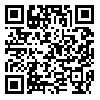BibTeX | RIS | EndNote | Medlars | ProCite | Reference Manager | RefWorks
Send citation to:
URL: http://tbj.ssu.ac.ir/article-1-2402-en.html

 , Ali Dehghani
, Ali Dehghani 
 , Masoome Abbasi shavazi
, Masoome Abbasi shavazi 
 , Abolfazl Barkhordari
, Abolfazl Barkhordari 
 , Farokh Legha Servat *
, Farokh Legha Servat * 

Introduction: Today, one of the issues that threatens human resources is job burnout. If a person is in such situation, negative changes occur in his/her attitudes, mood, and behavior. Then he/she emotionally fatigued and gradually feels lack of competence in fulfillment of his/her duties Therefore, the aim of this study was to investigate the rate of job burnout and its related factors in textile industry workers.
Methods: This analytical study was conducted on 200 workers of a textile company selected through stratified sampling method. The data collection instrooments consisted of a demographic characteristics questionnaire, and Maslach job burnout standard 22-item questionnaire. After codification, data were analyzed through the SPSS (version 16), descriptive statistics, ANOVA, T-test, and correlation coefficients.
Results: The mean of workers' job burnout was 52.2±24.88 which is placed at the average level of job burnout. In this study, 59 % of workers had low personal competence, 52% suffered from severe emotional exhaustion, and 25% had severe level of depersonalization. Significant correlations were reported between burnout and its dimensions (p= 0.001), as well as between job burnout and education, marital status, work experience, income satisfaction, housing, workplace lighting condition, sounds in workplace, satisfaction from workplace , smoking, and exercise. However, no significant correlation was observed between the number of children and the disease.
Conclusion: Due to the high status of job burnout and its dimensions and their negative effects on workers' performance and mental health, training programs and skill enhancement workshops are recommended. Meanwhile, the company's management is required to pay more attention to workers' demands and attract them to participate in the programs.
Received: 2017/01/8 | Accepted: 2017/03/12 | Published: 2018/03/14
| Rights and permissions | |
 |
This work is licensed under a Creative Commons Attribution-NonCommercial 4.0 International License. |



